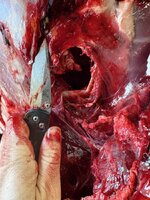Sundodger
WKR
That cartridge hasn’t been invented yet.
The fastest I pushed mono’s was 3450 mv, 3400 impact velocity, and it was nowhere even close to the tissue damage that I get from an ELD m at 2200 impact velocity.
I am your people. I just realize your listing criteria out that won't result in "plotted lines crossing". I'm not really sure how it isn't clear that a bullet with bent petals and frontal area pushing through an animal will NEVER have the same effect on tissue as one that has fragmented and is cutting through tissue in tension due to the hydrostatic shock thus damaging more tissue in a pattern a petal peeling mono will never replicate.
This isn't bagging on monos, I hunt monos, I just accept what they are and how they perform and deploy them accordingly.
I suspect it might not be exactly where you guys have been looking.
Been doing more muzzy hunting in recent years, taken 7 animals in the range of 20 yards (1600ish FPS impact velocity) to 125 yards (1200ish FPS impact velocity) using an interesting bullet the federal bor lock. It’s copper with a sliding sealing skirt of sorts, but with what looks relief cuts in the bullet to facilitate disruption. At 20 yards it is a little too destructive for my taste, losing more rib meat than I like. At the end of it’s supersonic range (just before it goes transonic) it’s pretty great, caliber sized entrance and turns the lungs completely to liquid and jelly with very little meat damage. I also have recovered most of the bullets.
If you read my posts in this thread I have actually said nothing about monos, just talking about the bullets along the continuum of destructiveness of which mono’s lay. While I have hunted with monos, I don’t get religious attachment to bullet designs. I was just hoping labeling them projectile X and Y would help people.


